In a world increasingly filled with noise, clutter, and complexities, the call for simplicity resonates louder than ever.The living room, often considered the heart of the home, is the perfect canvas for embracing a minimalist approach. Imagine a space where every piece not onyl serves a purpose but also contributes to an atmosphere of calm and comfort. ”” invites you on a journey to discover how thoughtful design choices can transform your living area into a sanctuary of tranquility. Through the principles of minimalist aesthetics, we will explore innovative ideas and practical tips for creating a harmonious surroundings that reflects your personal style while eliminating the superfluous. Join us as we delve into the beauty of less,revealing how compact living can lead to a richer,more meaningful way of life.
Embracing Natural Light for a Warm and Inviting Atmosphere in Minimalist Designs
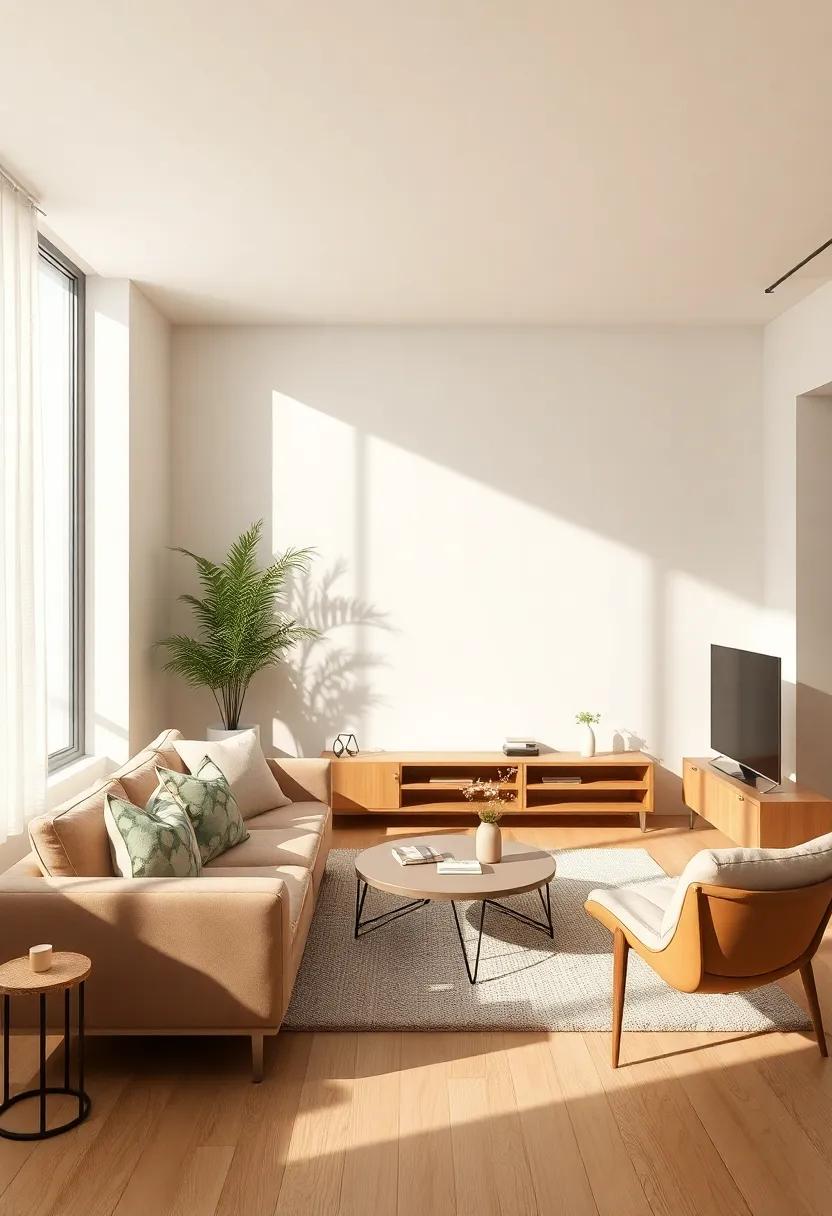
natural light acts as a transformative element in minimalist design, infusing spaces with warmth and a sense of openness. By strategically placing windows and utilizing light-filtering curtains, you can enhance the radiant, airy feel of a compact living room. Consider maximizing daylight through the following approaches:
- Choose light-colored walls to reflect sunlight
- incorporate mirrors to bounce light around the room
- Opt for translucent materials for furniture or decor
In a well-lit space, the simplicity of minimalist design can shine even brighter, allowing each element to speak for itself. The interplay between light and your carefully chosen furnishings creates a serene yet inviting environment.You might also explore the following ideas to maintain an organic feel:
| Element | Effect |
|---|---|
| Plants | Adds life and texture, enhancing calmness |
| Textured fabrics | Softens the look while retaining simplicity |
| Wood Accents | Brings warmth and natural vibes to the space |
The Power of a Neutral Color Palette in creating Serenity and Balance
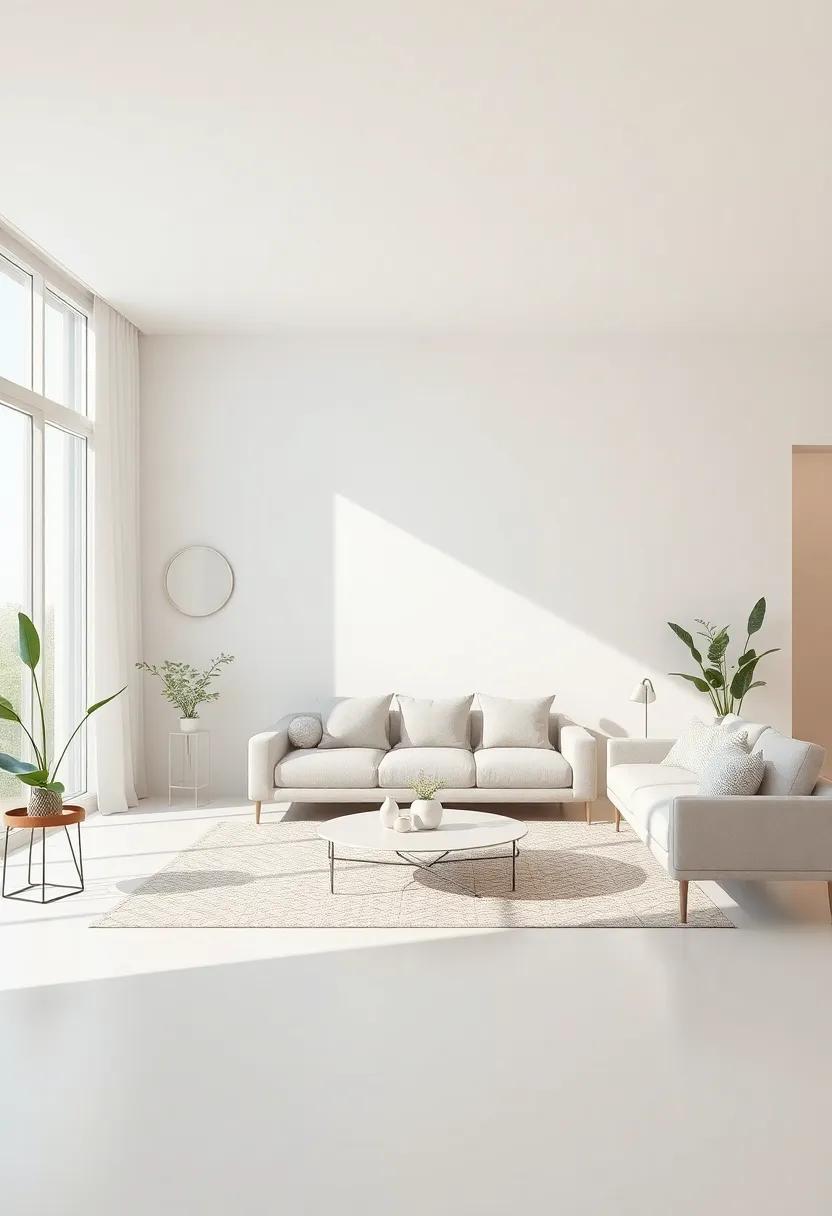
In a world that frequently enough overwhelms the senses, a neutral color palette offers a sanctuary of calm and tranquility. Utilizing soft shades of cream, beige, taupe, and grey can transform a minimalist living room into a serene retreat that invites relaxation. When these colors are paired with natural materials such as wood and stone, they foster an ambiance that promotes harmony and balance. This selection not only allows for seamless integration of design elements but also creates a backdrop that highlights personal touches and decor without distractions.
Consider incorporating a variety of textures within your neutral palette to maintain visual interest while preserving tranquility. Here are a few ways to enhance the serene effect:
- Layered textiles: Use cushions,throws,and rugs in soft fabrics to create warmth and depth.
- Natural accents: Introduce plants or organic decor elements to bring the outside in.
- Subtle patterns: Add visual intrigue with gentle patterns on fabrics or wallpapers that echo the color scheme.
Incorporating Functional Furniture for a Practical and Stylish Living Room
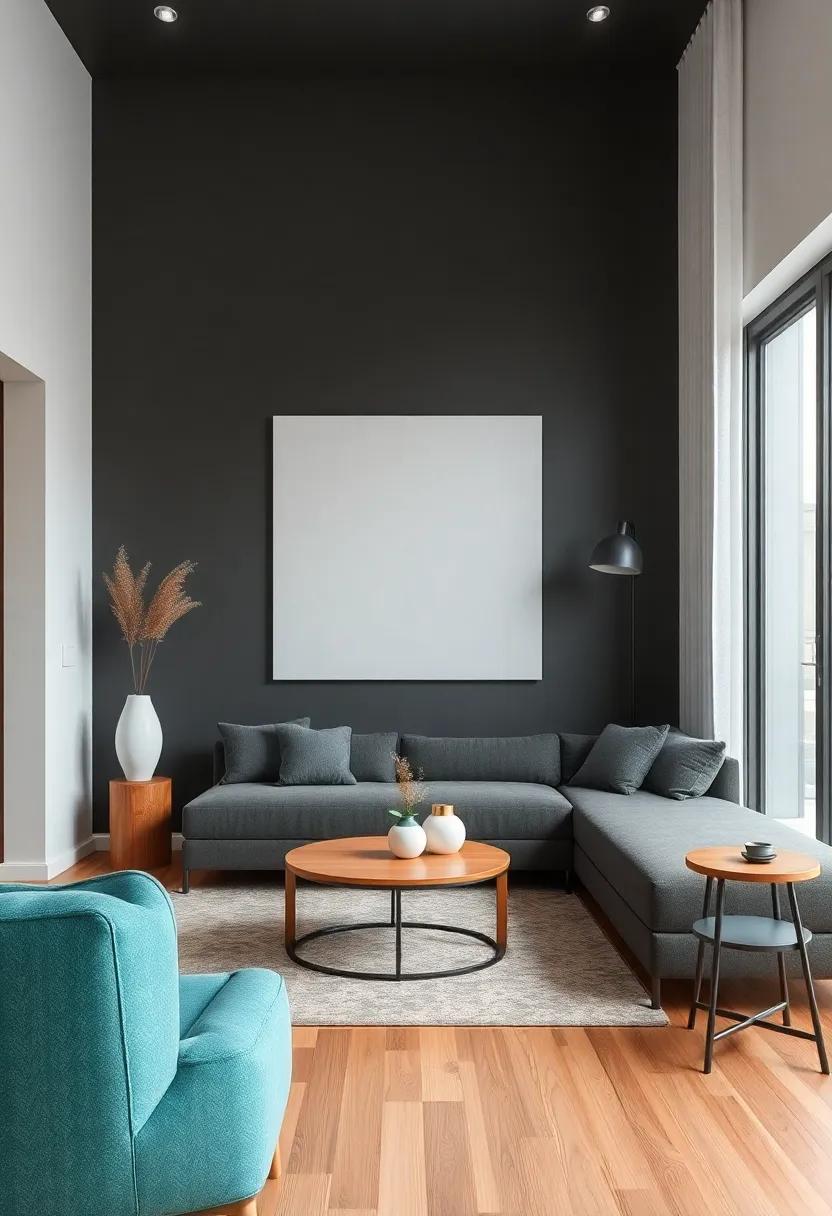
Creating a harmonious living room that exudes both practicality and style begins with the right choice of furniture. Functional furniture items can serve multiple purposes, making the moast of your limited space while enhancing the aesthetic appeal of the room. Key pieces to consider include:
- Multi-functional sofas: Opt for sofas that can convert into beds or come with built-in storage.
- Ottomans: Use ottomans as footrests, coffee tables, or additional seating options.
- Wall-mounted shelves: These save floor space while providing display and storage opportunities.
Incorporating these elements not only optimizes space but also contributes to a minimalist design ethos. To ensure a cohesive environment, choose furniture that reflects a unified color palette and simple lines. Consider the following layout strategies:
| Layout Strategy | Description |
|---|---|
| Zone Definition | Use rugs and lighting to define areas for sitting, reading, and entertaining. |
| Vertical storage | Utilize tall bookshelves or cabinets to draw the eye upward, maximizing perceived space. |
The Art of Choosing Statement Pieces that Reflect Your Personality
Every living room can become a canvas for self-expression through carefully selected statement pieces that embody your essence.When choosing items, consider what resonates with you personally—color, shape, and texture all contribute to creating a sensory experience. Opt for elements that tell a story, whether it’s an eye-catching sculpture or a vibrant piece of wall art. These focal points should not only stand out but also harmonize with the surrounding décor, paving the way for a cohesive and inviting atmosphere.
Moreover, it’s essential to maintain a balance between simplicity and expression. Here are crucial aspects to contemplate when selecting statement pieces:
- Emotional Connection: Choose pieces that evoke memories or feelings, strengthening your bond with the space.
- Scale and Proportion: Ensure that the size of the statement pieces is proportionate to the room, allowing them to shine without overwhelming.
- Versatility: Opt for items that can seamlessly blend with varying styles or adapt to future changes in décor.
| Statement Piece | Personality Reflection |
|---|---|
| Artistic Canvas | Conveys creativity and passion. |
| Bold Sculpture | highlights confidence and individuality. |
| Unique rug | Embodies warmth and comfort. |
Creating Visual Harmony with Simple Wall Art and Decor Choices
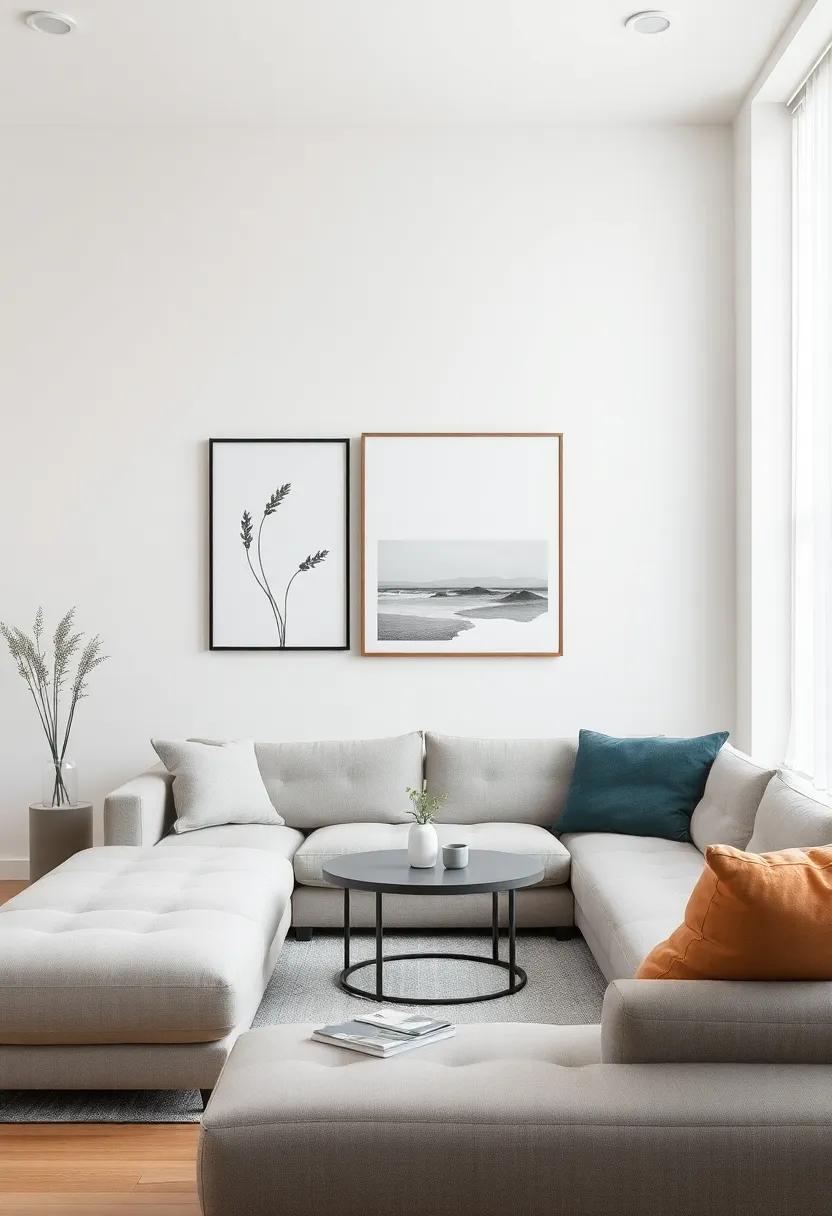
in a world where less is more, the choice of wall art and decor can be pivotal in crafting a serene living space. By opting for simple designs that resonate with your personal aesthetic, you can create a visually cohesive atmosphere. consider selecting a few pieces that share a common theme or color palette to pull your room together. Here are some ideas to integrate art seamlessly:
- Choose monochromatic prints that complement your furniture.
- Incorporate nature-inspired elements, like botanical prints or landscapes.
- Use geometric shapes to create a modern and orderly visual appeal.
- Hang art at eye level to create a focal point and invite engagement.
When it comes to decor choices, simplicity is key. Pair your wall art with understated accessories that enhance rather than overwhelm the space. A few well-placed decor items can harmonize with your artwork and emphasize the room’s minimalist essence.Consider the following elements:
| Decor Element | Purpose |
|---|---|
| Indoor Plants | Add greenery and life, promoting a fresh atmosphere. |
| simple Vases | Offer elegance without clutter; perfect for a single flower or branch. |
| Warm Lighting | Create a cozy ambiance that complements your art. |
Emphasizing Open spaces to enhance Airiness and Freedom in Design
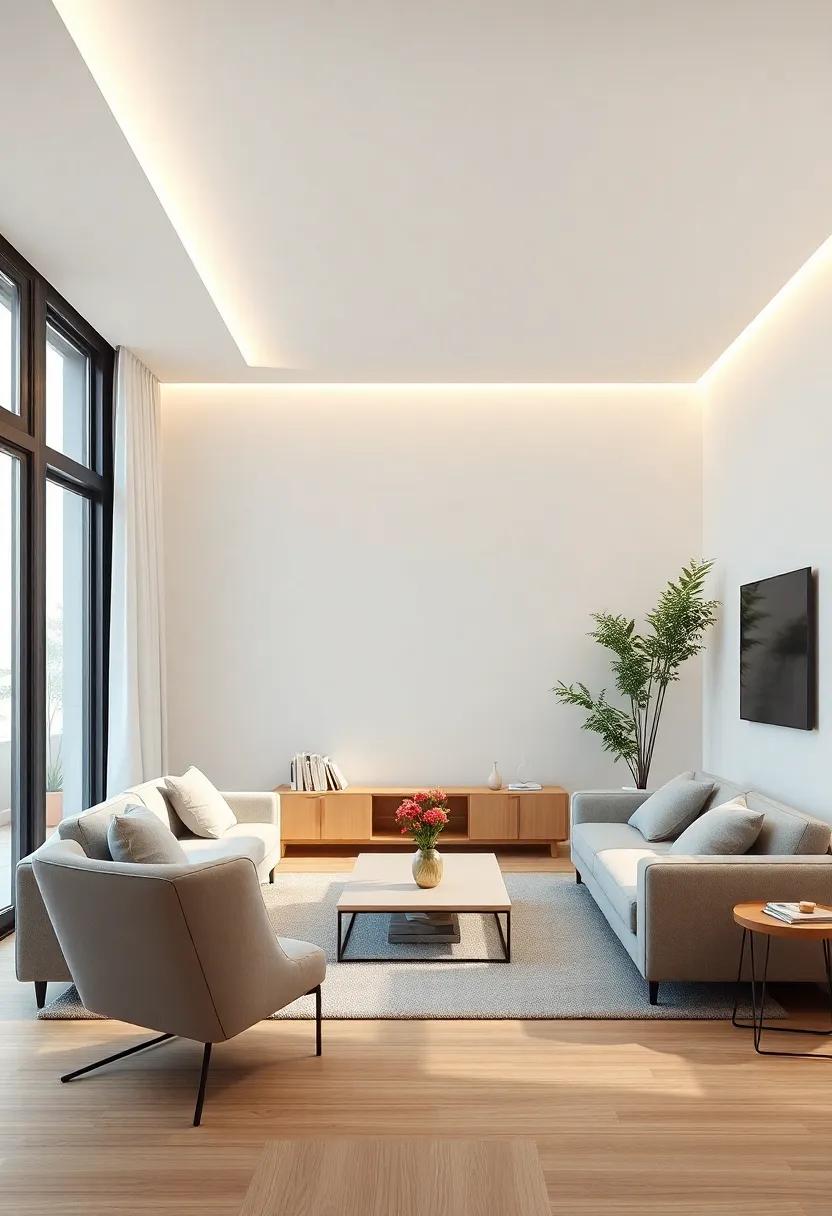
incorporating ample open spaces into the design of a compact minimalist living room can substantially heighten the sensation of airiness and freedom. Utilizing a few strategic design principles can help achieve this effect:
- Color Palette: Light,neutral colors for walls and furnishings can create a seamless visual flow,making the space feel larger and more open.
- Furniture Arrangement: Positioning furniture away from walls can enhance the flow of movement, allowing air and light to circulate freely.
- Natural Light: Maximizing windows and choosing lightweight drapes can invite sunlight, further expanding the perceived space.
Another essential aspect to consider is the use of multifunctional furniture that maintains an uncluttered aesthetic. By opting for items that serve dual purposes, such as a coffee table with storage or a sofa bed, you not only reduce overcrowding but also promote an effortless ambiance. Moreover, integrating vertical elements like shelves or artwork can draw the eye upward, contributing to a sense of spaciousness. Below is a fast comparison of furniture styles that support this vision:
| Furniture Type | Benefits |
|---|---|
| Modular Sofas | Flexible layout options, encourages open pathways |
| Transparent Furniture | Creates visual lightness while maintaining functionality |
| Foldable Tables | Easily stored when not in use, freeing up floor space |
Utilizing Smart Storage Solutions to Reduce Clutter and Enhance Style
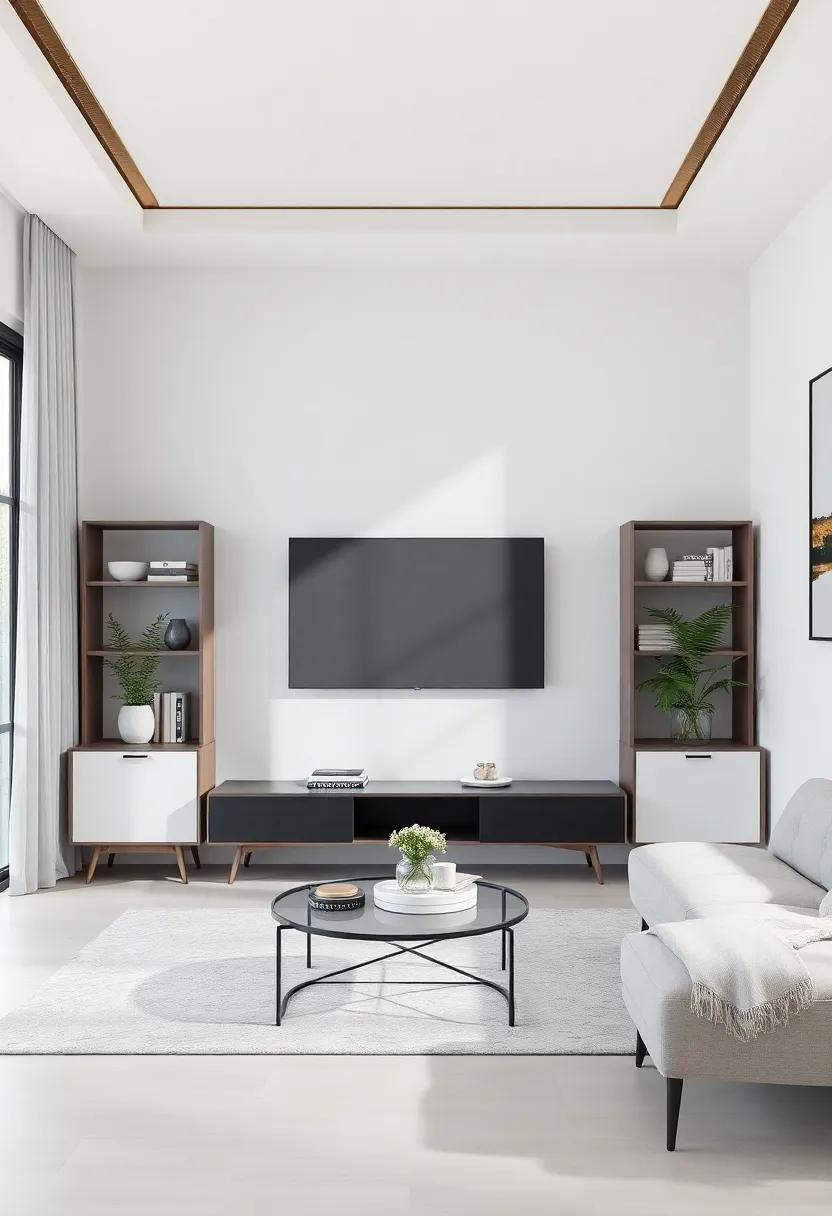
In the quest for a minimalist living room,smart storage solutions become the silent champions,working effortlessly to blend functionality with aesthetic charm. Consider integrating furniture that doubles as storage, such as ottomans with hidden compartments or coffee tables that open to reveal space for magazines and remote controls. these multifunctional pieces not only free up visual clutter but also serve as statement decor items, adding to your room’s overall design. Here are some innovative ideas:
- Wall-mounted shelves: Create vertical storage that can display decorative items while keeping the floor space clear.
- Built-in cabinetry: seamlessly integrate storage units into your walls for a streamlined look.
- Baskets and bins: Use stylish woven baskets to store throw blankets or toys, adding texture without compromising style.
- Floating consoles: emphasize a spacious feel by suspending storage solutions off the floor.
To further refine your approach, it’s essential to curate your belongings, allowing only the items that serve a purpose or evoke joy to remain visible. A well-organized storage plan can transform your living room into a serene sanctuary.Implement a seasonal declutter routine to refresh your space and keep things organized.Consider employing a simple table to track what items need to be stored, donated, or discarded:
| Category | Action | Frequency |
|---|---|---|
| clothes | Donate | Seasonal |
| Books | Store | Annual |
| Decor Items | Rotate | Biannual |
| Tech Gadgets | Discard | As needed |
Integrating Textures for Depth and Interest in a Minimalist Living Room
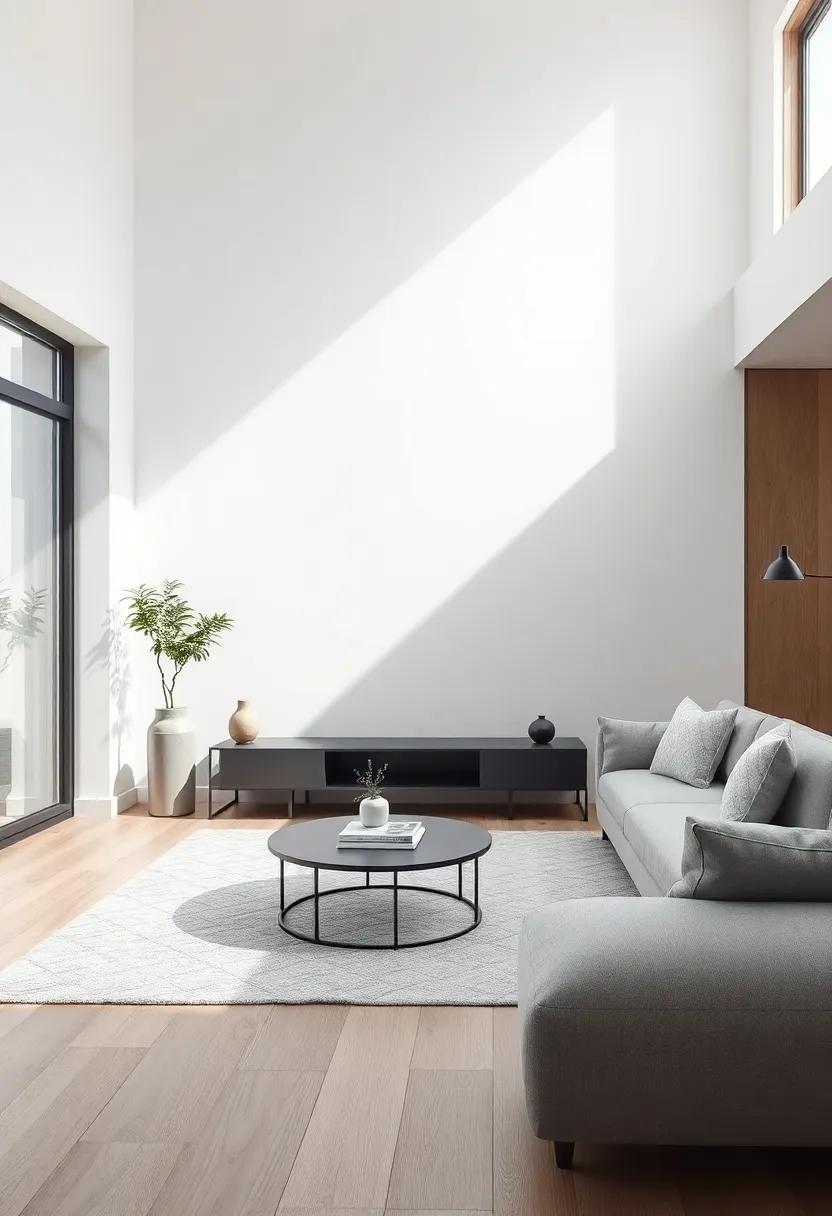
In a minimalist living room,where every piece counts,integrating various textures can add layers of depth and interest without overwhelming the space. Consider incorporating materials such as natural wood, soft textiles, and smooth ceramics to create a harmonious balance. As an example,a sleek wooden coffee table paired with plush cushions can foster a cozy yet elegant atmosphere. Accent items like a woven throw or a textured rug introduce tactile pleasure, inviting guests and residents alike to engage with the surroundings through their senses.
To further enhance the visual appeal, use color variations that complement your existing palette.Choose neutral tones for large furnishings and introduce pops of color through textured accessories. An effective way to visualize this is through a simple table of inspiration:
| Texture | Material | Color Palette |
|---|---|---|
| Woven Basket | Natural Fiber | Beige, Soft White |
| Chunky Knit Throw | Wool/ Acrylic | Muted Gray, Dusty Blue |
| Vase | Glazed Ceramic | Matte White, Earthy Green |
Crafting Cozy Nooks with Thoughtful Arrangements of Seating and Lighting
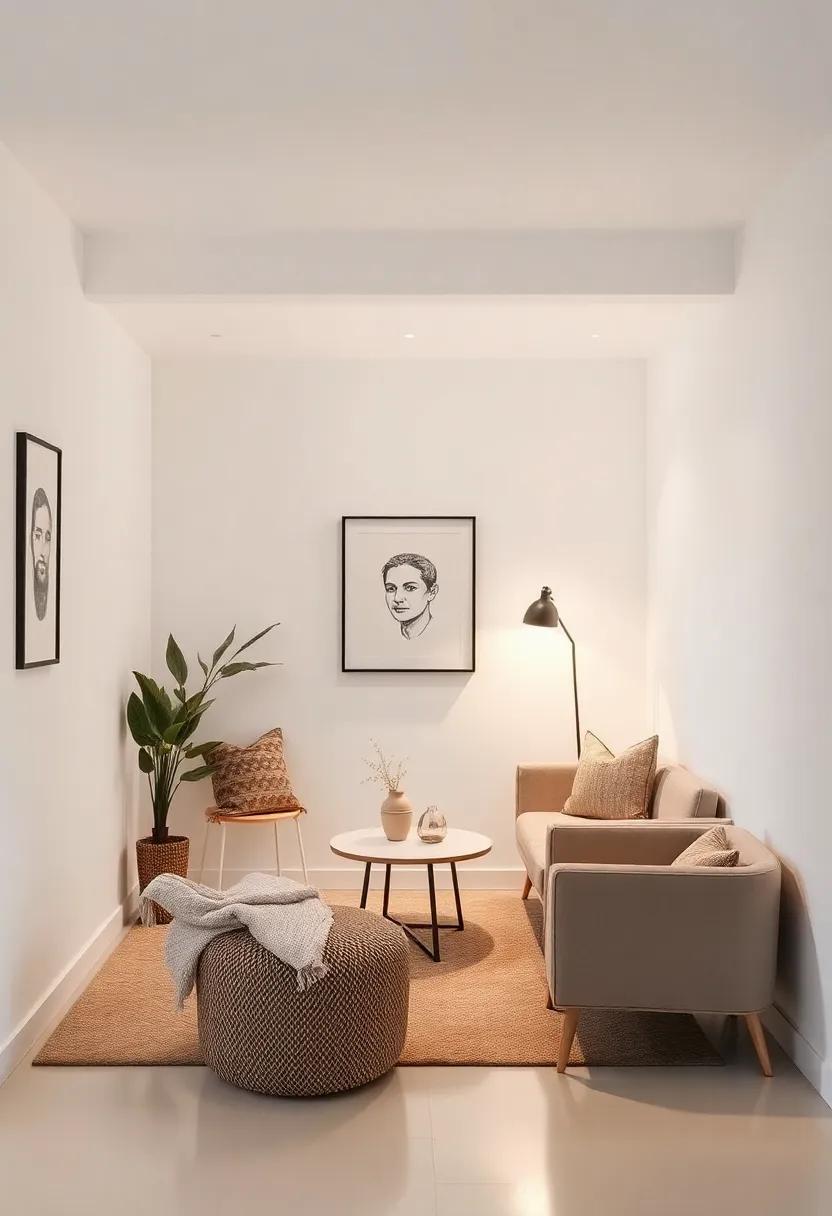
Creating intimate spaces within your living room starts with the careful selection and arrangement of seating. Opt for compact furniture that encourages conversation and warmth rather than isolation. Consider using a combination of a small, inviting sofa and a couple of oversized, soft armchairs to establish a central gathering area. Layering textiles, such as plush throws and an array of cushions, can enhance the cozy factor, making each seat not only a place to sit but also a sanctuary to unwind. Complement these choices with strategically placed side tables to ensure convenience and maintain a clean visual flow.
Lighting plays a crucial role in defining the atmosphere of a cozy nook. Incorporate a mix of ambient and task lighting to create versatility and warmth. A soft-glow floor lamp alongside dimmable pendant lights can allow you to adjust the mood from activity to relaxation effortlessly. Consider adding decorative table lamps on side tables to add personal flair and enhance the intimate feel. For an added touch, incorporate soft-lit candles or fairy lights to bring a whimsical glow, making your cozy area perfect for reading, reflection, or simply enjoying the moment.
Balancing Aesthetics with Comfort in Compact Living Spaces
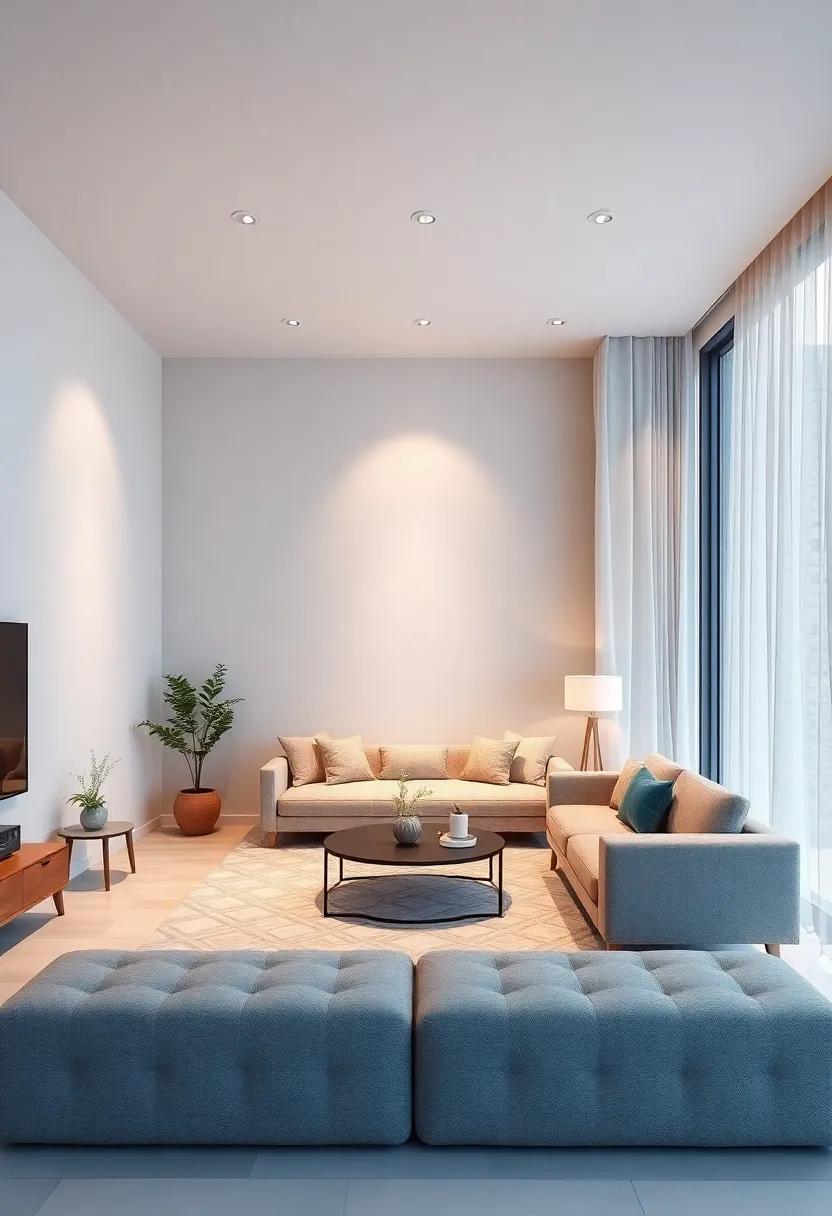
In compact living spaces, the challenge lies in achieving a harmonious balance between aesthetics and comfort. opting for multifunctional furniture pieces can facilitate this balance effectively. For example, a stylish ottoman can serve as both a footrest and a storage solution, while a sleek coffee table may double as a workspace. Emphasizing simplicity in furniture choice allows for the creation of an uncluttered visual atmosphere, making the space feel larger while still being practical for everyday living. Consider incorporating design elements like:
- Neutral color palettes to evoke calmness
- natural textures, such as wood or linen, to add warmth
- Strategic lighting that enhances the room’s depth and character
Another key aspect is to infuse personal touches without overwhelming the senses. Selection of decor items should revolve around their sentimental value and functional appeal. For instance, a gallery wall can showcase cherished memories in a visually stimulating way while maintaining coherence with the overall design. When looking at layout options, prioritize open space; consider a layout that flows and invites movement. To guide your arrangement, the following table outlines some essential elements to assess:
| element | Consideration |
|---|---|
| Furniture Size | Ensure proportionality to the room |
| Color Scheme | Use a cohesive palette for visual continuity |
| Textural Variety | Mix textures to create visual interest |
| Personal Touch | Incorporate items reflecting your personality |
Selecting Plants that Elevate the Ambiance Without Overwhelming the space
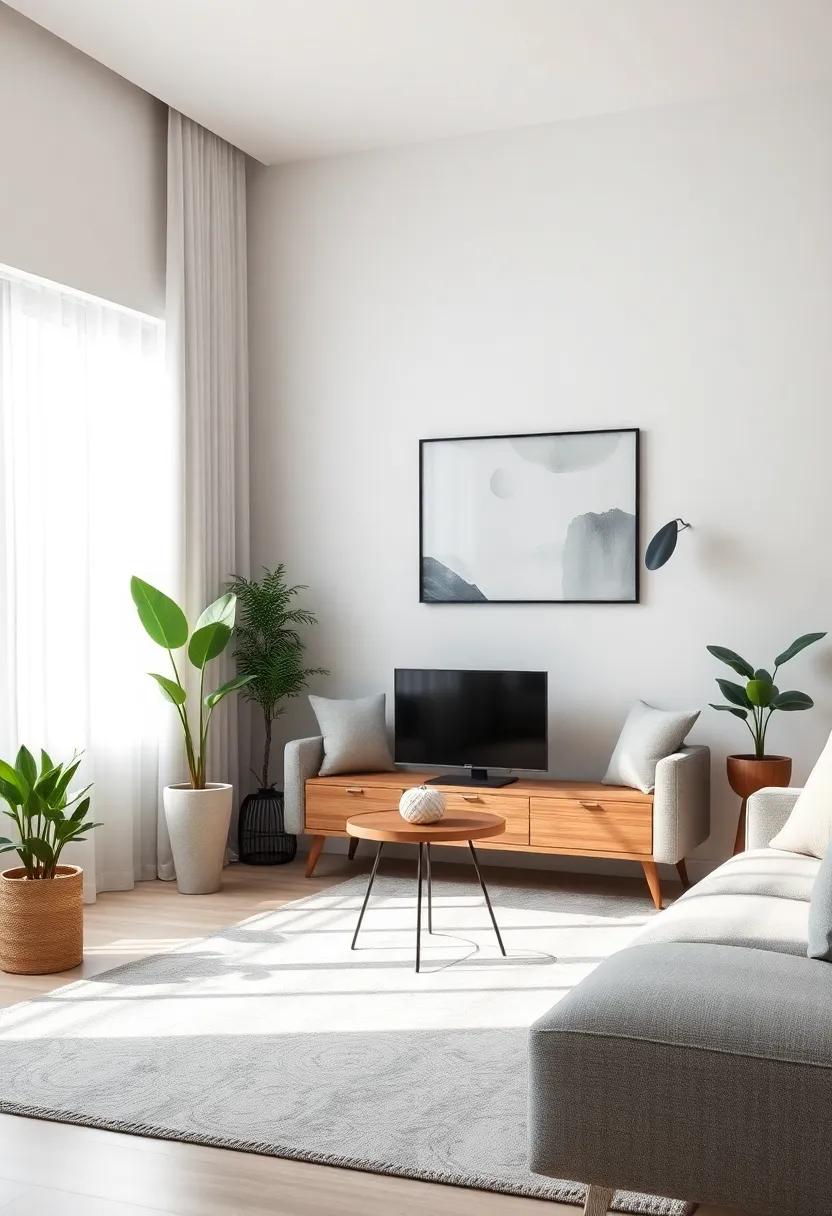
When it comes to selecting plants that complement a minimalist living room, it’s essential to embrace choices that enhance the space without dominating it. consider opting for low-maintenance varieties that bring life and vibrancy while maintaining a subtle presence. Here are some excellent options:
- Snake Plant: This hardy plant not only purifies the air but also fits snugly into small corners.
- Pothos: Known for its trailing vines, it can be easily placed on shelves or in hanging planters.
- Peace Lily: A delicate bloom that adds a touch of elegance without being overwhelming.
To ensure that the plants harmonize with your space, consider their placement and proportion. utilize minimalist pots that resonate with the clean lines of your decor, keeping the color palette neutral to avoid visual clutter. You might even create a simple arrangement with multiple plants to form an engaging yet understated focal point. Here’s a simple table to summarize the best practices for plant selection:
| Plant Type | Light Requirements | Size |
|---|---|---|
| Snake Plant | Low to bright indirect light | 2-4 feet tall |
| Pothos | Low to bright indirect light | Varies (1-10 feet depending on growth) |
| Peace Lily | Low to medium indirect light | 1-3 feet tall |
Using Area Rugs to Define Zones and Add Warmth in Minimalist Environments
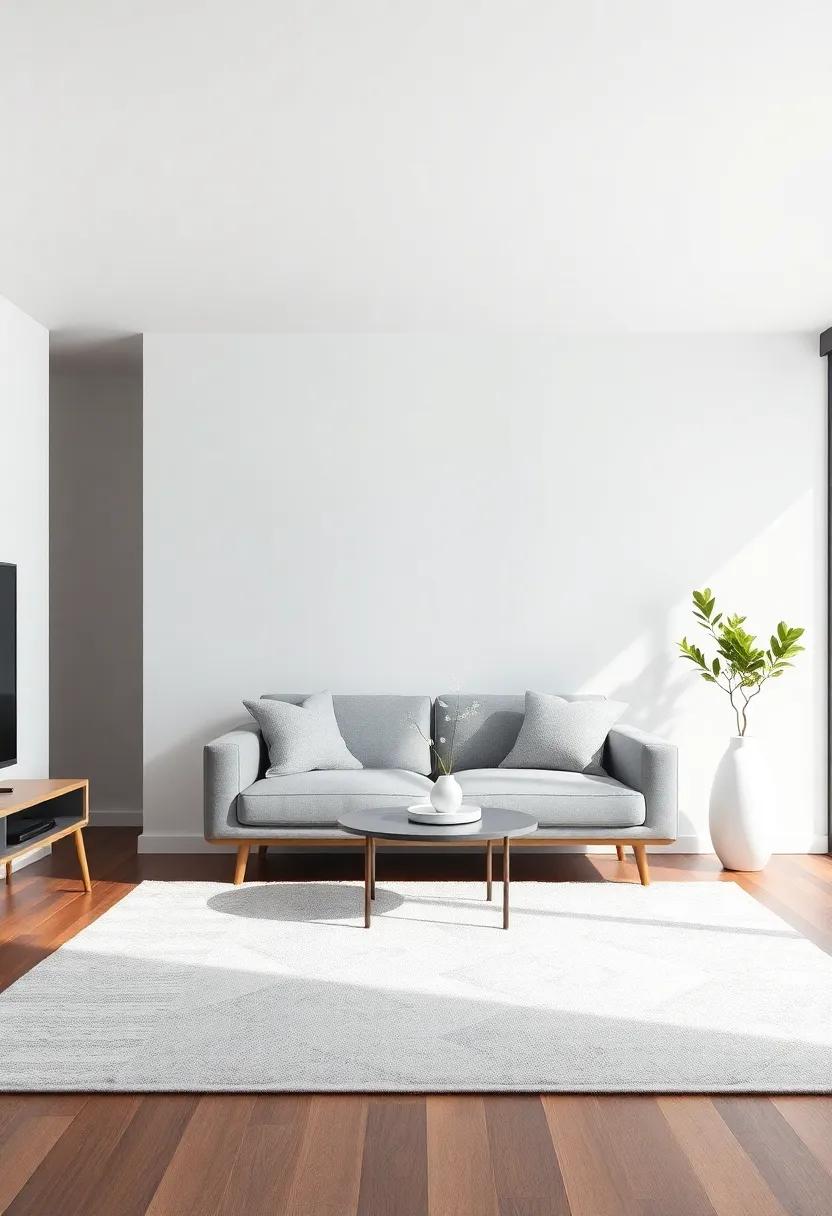
In a minimalist environment, the strategic placement of area rugs can transform space by demarcating specific zones while simultaneously infusing a sense of warmth and comfort. By choosing rugs with rich textures and subtle patterns, you can create welcoming areas that invite relaxation and conversation. Consider the following approaches:
- Defining Spaces: Use a larger rug to anchor the seating area,providing a cohesive focal point in an otherwise open layout.
- layering: Layer smaller rugs over larger ones to create depth, adding visual interest without overwhelming simplicity.
- Color Coordination: Select rugs that harmonize with your color palette to maintain flow while adding depth and character.
moreover, rugs can effectively delineate functional areas such as a reading nook or a workspace without the need for physical barriers. Apply these simple ideas to maximize the functionality of your living area:
| Zone | Rug type | Purpose |
|---|---|---|
| Seating Area | Large, plush | Encourage relaxation and social interaction |
| Reading Nook | Soft, circular | Create an inviting retreat |
| Workspace | Flatweave | Define the area without distraction |
By thoughtfully integrating area rugs into your minimalist design, you instill warmth and appeal while maintaining a clean and uncluttered aesthetic. This approach not only enhances the overall ambiance of the space but also elevates the functionality of each zone you create.
Highlighting Architectural features to Add Character and Charm
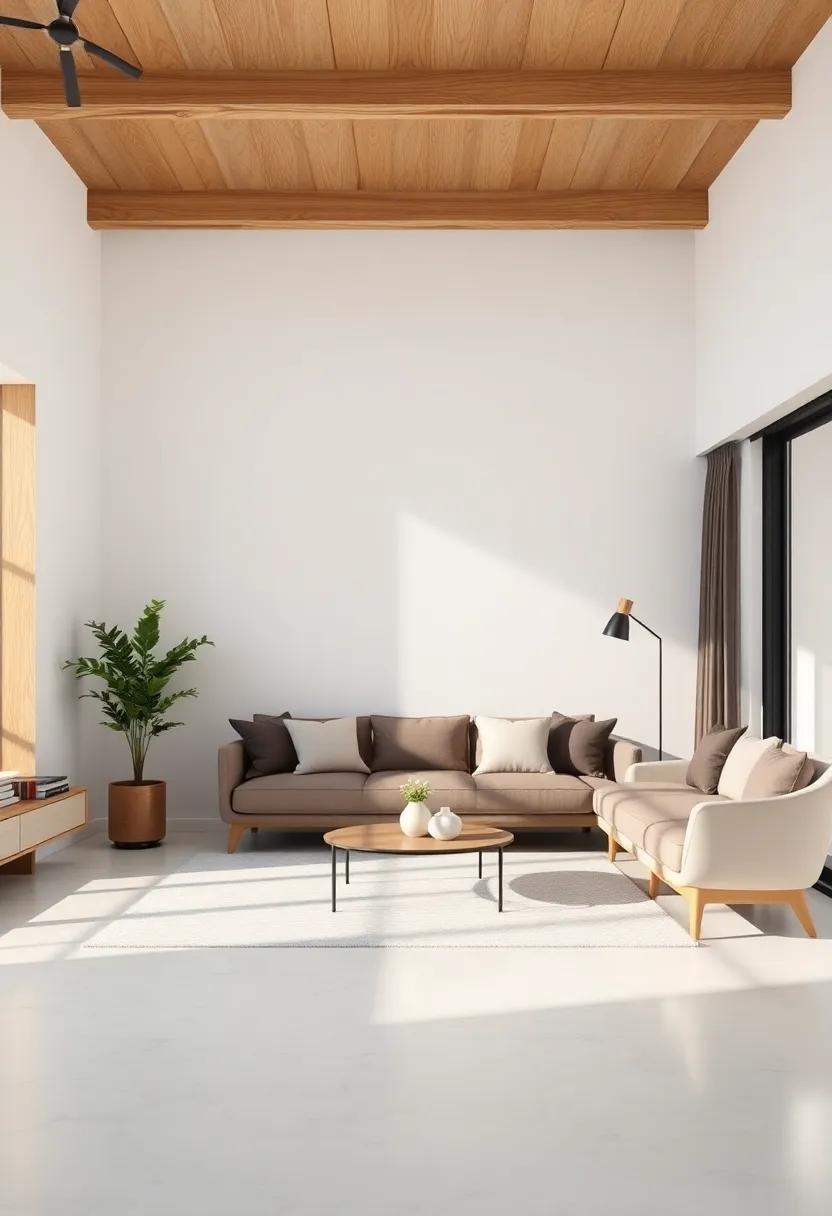
In a compact minimalist living room, architectural features play a crucial role in adding depth and warmth to the space.Consider enhancing the character of your room with the following elements:
- Exposed Beams: Uncovering wooden beams can create a rustic charm that draws the eye upward, making the space feel larger.
- Built-In Shelving: Utilize built-ins to maximize floor space while showcasing decor, books, or personal treasures.
- Color & Texture: Incorporate textured walls or accent colors to add visual interest without overwhelming the minimalist aesthetic.
Strategically placed windows and natural light sources can further enhance the design’s character. Consider a layout that allows for:
| Design Element | Impact on Space |
|---|---|
| Large Windows | Creates an open feel and connects the indoor space with nature. |
| Floor-to-Ceiling Curtains | Adds height and drama, while also softening the lines of the room. |
Exploring Lighting Options that Foster Atmosphere and Discussion
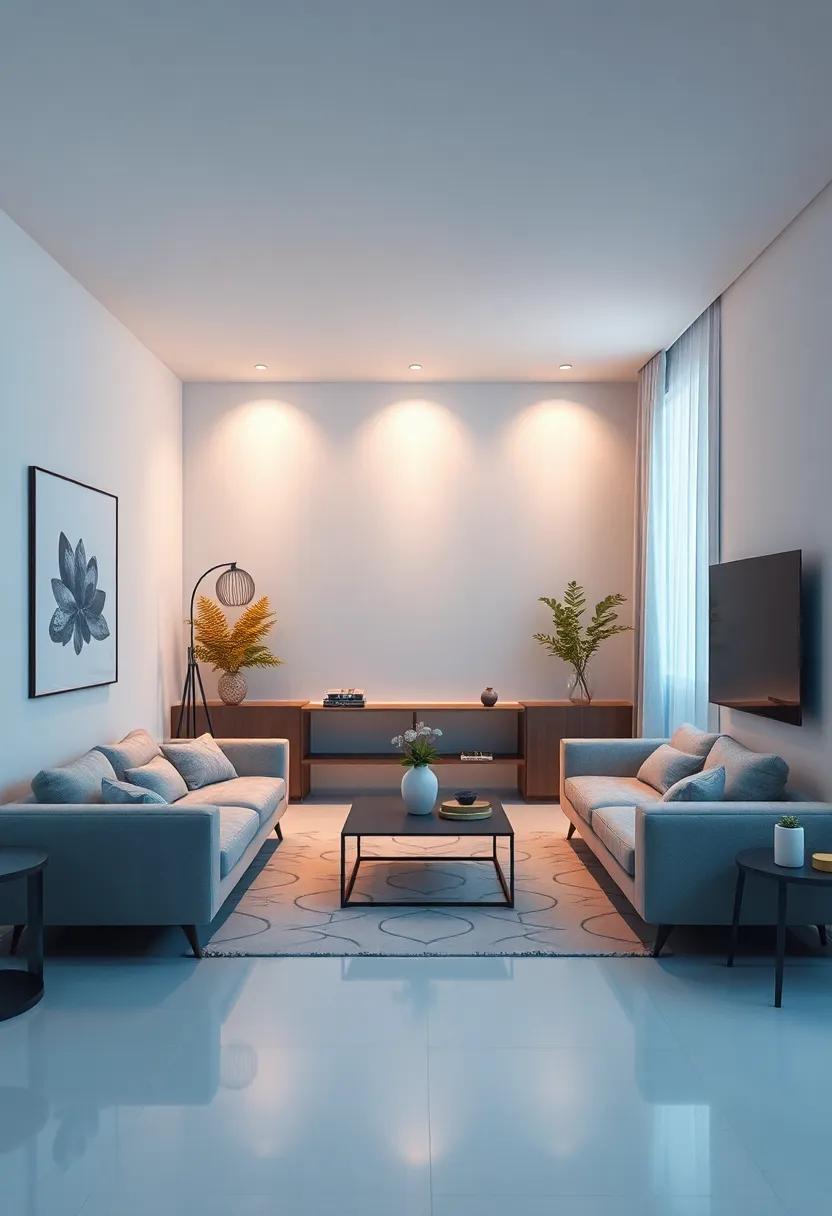
Lighting is one of the most powerful yet frequently enough overlooked tools in creating an inviting living space. When curating a minimalist design, it’s essential to choose fixtures that not only serve a functional purpose but also foster warmth and encourage conversation. Soft ambient lighting, such as recessed lights or strategically placed lamps, can create a cozy atmosphere. Meanwhile, accent lights highlighting artwork or architectural features can spark discussion, inviting guests to engage with both the space and their surroundings. Here are some options to consider for an effective balance:
- Floor Lamps - Offer flexibility and can double as statement pieces.
- Table Lamps – Ideal for creating intimacy during conversations.
- Wall Sconces – Save space while providing soft illumination.
- Dimmer Switches – Allow adjustment for mood setting and versatility.
In a minimalist living room, the strategic use of lighting can enhance both functionality and aesthetics. Consider using a combination of natural and artificial light to create an environment that evolves throughout the day. Such as, during sunlight hours, light-diffusing window treatments can gently filter natural light, enhancing the minimal decor without overwhelming it. As evening approaches, switching on warm-toned fixtures can transition the space into a welcoming setting for guests. Below is a simple guide on how to layer lighting:
| Layer | purpose | option Examples |
|---|---|---|
| Ambient | General illumination | Ceiling lights, overhead fixtures |
| Task | Focused lighting for activities | reading lamps, under-cabinet lighting |
| Accent | Highlighting features or decor | Track lighting, spotlights |
The Importance of Scale in Selecting Furniture for a Cohesive Look
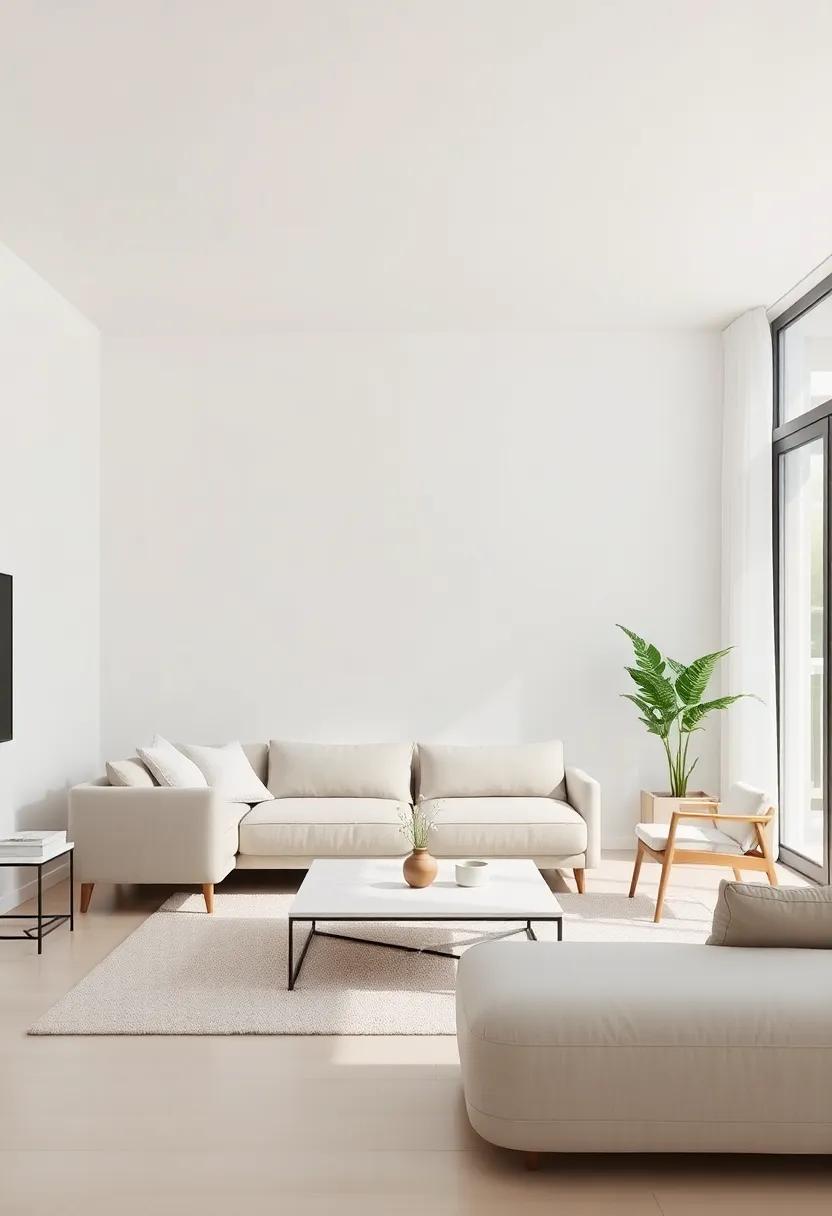
When designing a living room rooted in minimalist principles, understanding the scale of your furniture is crucial. Choosing pieces that are proportionately sized helps to create a harmonious space that feels open and inviting. Oversized furniture in a compact area can overwhelm the room, making it appear cluttered and chaotic. Instead, opt for items that enhance the room’s dimensions, such as slim profiles and multi-functional furniture. For instance, a sleek sofa paired with a compact coffee table can open the space, while providing the necessary comfort and style.
To maintain a cohesive look, consider the following points when selecting furniture:
- Height Variation: Incorporate furniture of differing heights for visual interest without bulk.
- Color Palette: Stick to a limited color palette to support the illusion of spaciousness.
- Openness: Use materials like glass or light woods that create a sense of airiness.
Additionally, utilizing a carefully curated selection of furniture allows for an easy flow throughout the space. A well-balanced arrangement can transform an ordinary room into a sophisticated sanctuary, celebrating simplicity while ensuring that each element serves a purpose.
Inspiring Ideas for Multi-Functional Spaces that Maximize Usability
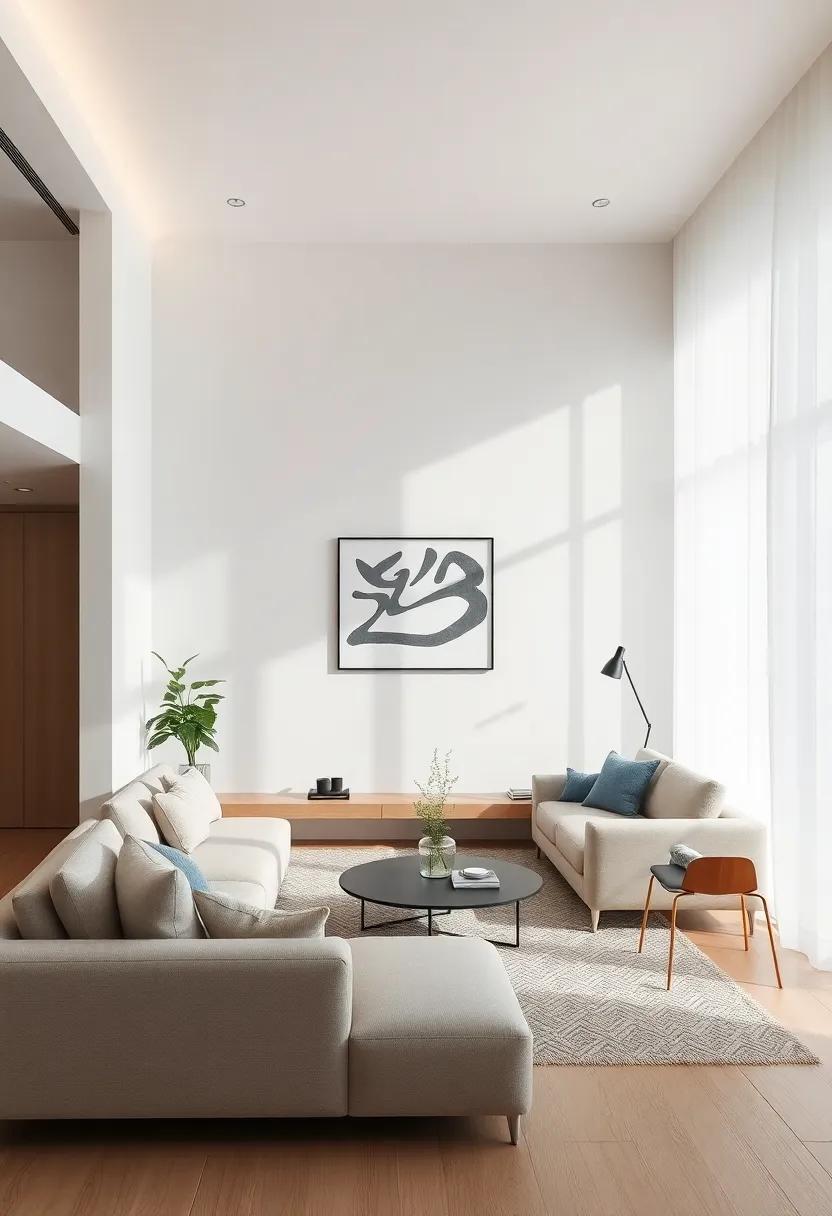
Transforming a conventional living room into a multi-functional space can breathe new life into your home. By embracing compact furniture,you can easily create areas that serve various purposes without overwhelming the aesthetic. Consider incorporating pieces like:
- Convertible sofas that transition from seating to sleeping arrangements.
- Nested tables that can be expanded or tucked away depending on the need.
- Ottomans with storage that provide both seating and a place to stow away items.
One effective layout strategy is the use of zoned areas within your living room. This can be achieved through clever use of rugs and lighting to demarcate spaces for different activities. Create a cozy reading nook with a comfortable chair and a small bookshelf, while designating another area for entertainment with a sleek media console. Consider adding a foldable desk or wall-mounted workspace to ensure that the space remains functional for remote work or hobbies, all without sacrificing style or comfort.
Creating a Focal Point that Draws Attention Without Cluttering
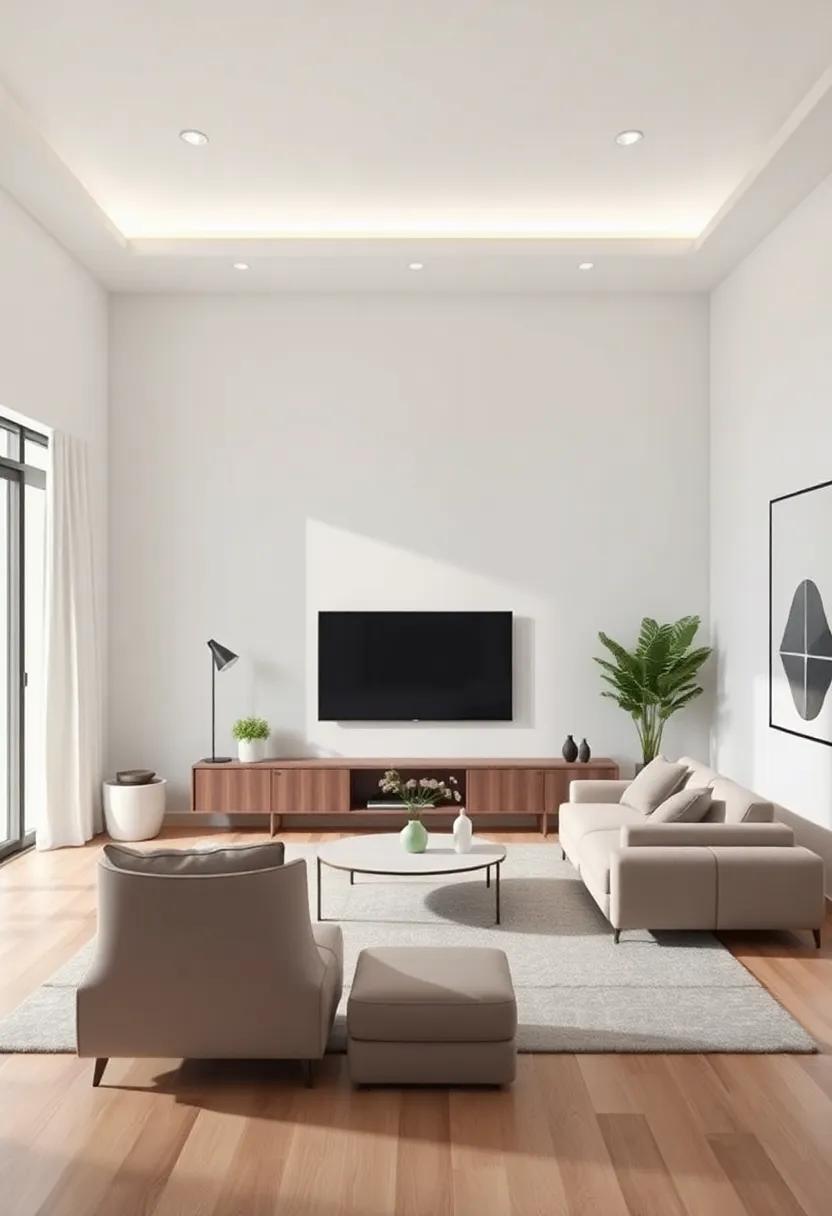
In a minimalist living room, creating a focal point requires a careful balance between attention and tranquility. To achieve a striking yet uncluttered centerpiece, consider implementing the following strategies:
- Statement Furniture: Choose a single, large piece, like an oversized armchair or a sculptural coffee table, that can serve as the visual anchor of the room.
- Art Selection: Opt for a bold piece of artwork or a sleek framed print that reflects your personality, but ensure it has ample white space around it to breathe.
- Natural Elements: Introduce a simple potted plant or flower arrangement to add life without overwhelming the space; the greenery will naturally draw the eye.
Lighting also plays a crucial role in highlighting your chosen focal point. Use a stylish floor lamp or pendant light to cast gentle illumination,enhancing the prominence of your centerpiece while maintaining a serene atmosphere. For an added touch:
- Layered Lighting: Combine ambient, task, and accent lighting to create depth.
- Dimmer Switches: Install dimmers to adjust the mood as needed, allowing your focal point to shine.
- Textures & Colors: Incorporate materials and hues that compliment your central focus, maintaining harmony without competing for attention.
Embracing Open Shelving to Showcase style and Accessibility
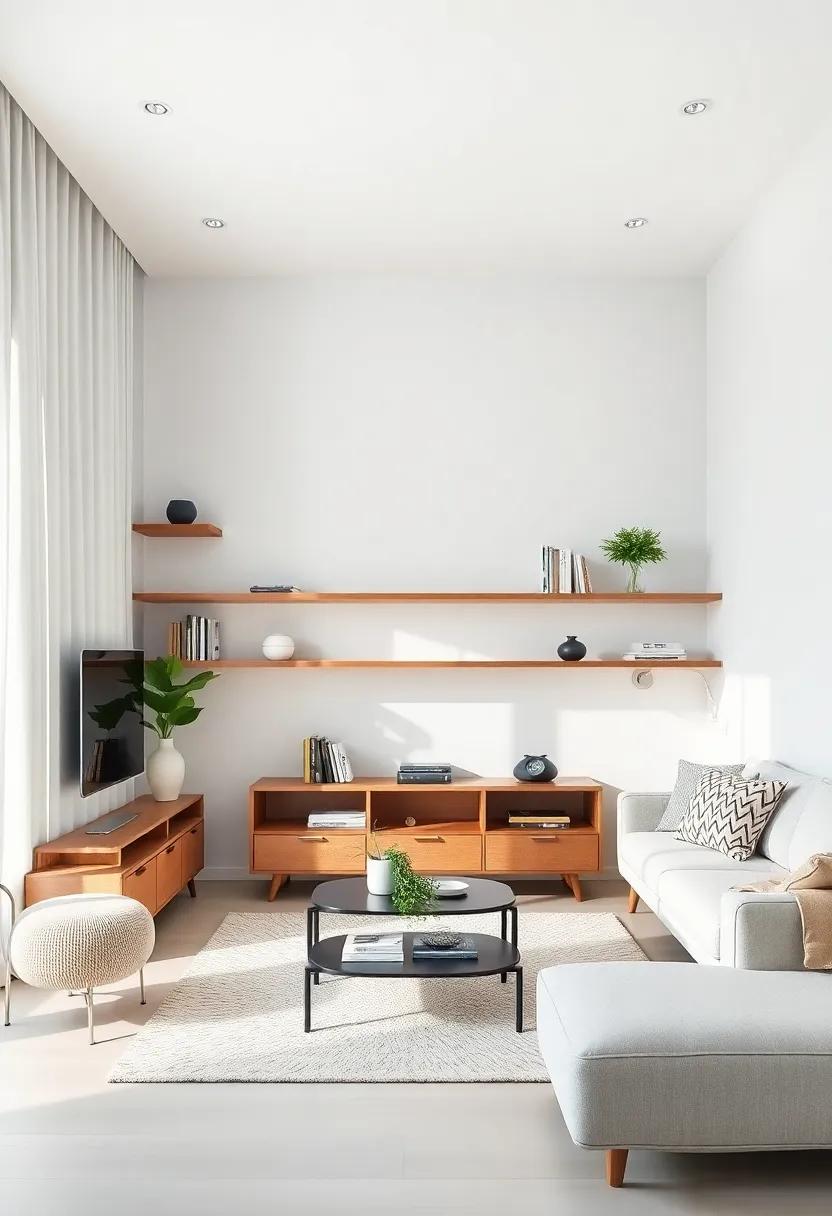
Open shelving transforms a living room into a curated gallery of personal style while enhancing accessibility.By removing customary cabinets, you not only create the illusion of more space but also invite a sense of openness to the room. This design choice encourages you to evaluate your belongings thoughtfully, as each item on display becomes part of your decor. Consider showcasing:
- Artistic Books: Stack your favorite reads for visual interest.
- Chic Decor Items: Use vases, sculptures, or framed photos that resonate with your personality.
- Greenery: Incorporate small plants for a touch of natural beauty.
Incorporating open shelving can also facilitate organization and function.By strategically placing functional items within easy reach, you turn your shelves into a practical resource that caters to your daily needs. Rather than resembling clutter, a well-arranged display promotes harmony and minimizes chaotic elements.Explore different layouts to maximize efficiency, such as:
| Shelf Type | Best Use |
|---|---|
| Wall-Mounted Shelves | Great for small spaces, showcasing decor and books. |
| Floating Shelves | Add dimension and keep things airy without floor space. |
| Open Pantry Shelving | Ideal for displaying kitchenware and spices. |
Utilizing Mirrors to Enhance Light and the Perception of Space

Mirrors are not merely decorative elements; they serve as powerful tools in expanding the ambiance of a compact living space. By strategically placing mirrors across from windows or light sources, you can amplify natural light, creating an airy and open atmosphere. The shimmer of reflected light not only brightens the room but can also reduce the need for additional lighting during the day. Consider incorporating various styles of mirrors, from sleek, modern frames to vintage pieces, to add character while maintaining a minimalistic aesthetic.
Additionally, the placement of mirrors can astutely alter the perception of space. A large mirror on one wall can visually double the dimensions of a room, while smaller mirrors can be grouped together to create a focal point that draws the eye upward, giving the illusion of height. To maximize this effect, aim for a balanced arrangement that complements your existing decor. here are some tips to consider:
- Position mirrors opposite colorful art or furniture for vivacity.
- Use mirrored furniture, like coffee tables or side tables, to subtly reflect light.
- Incorporate floor-to-ceiling mirrors to extend the verticality of the room.
Integrating Personal Touches that Reflect your Journey in Minimalism
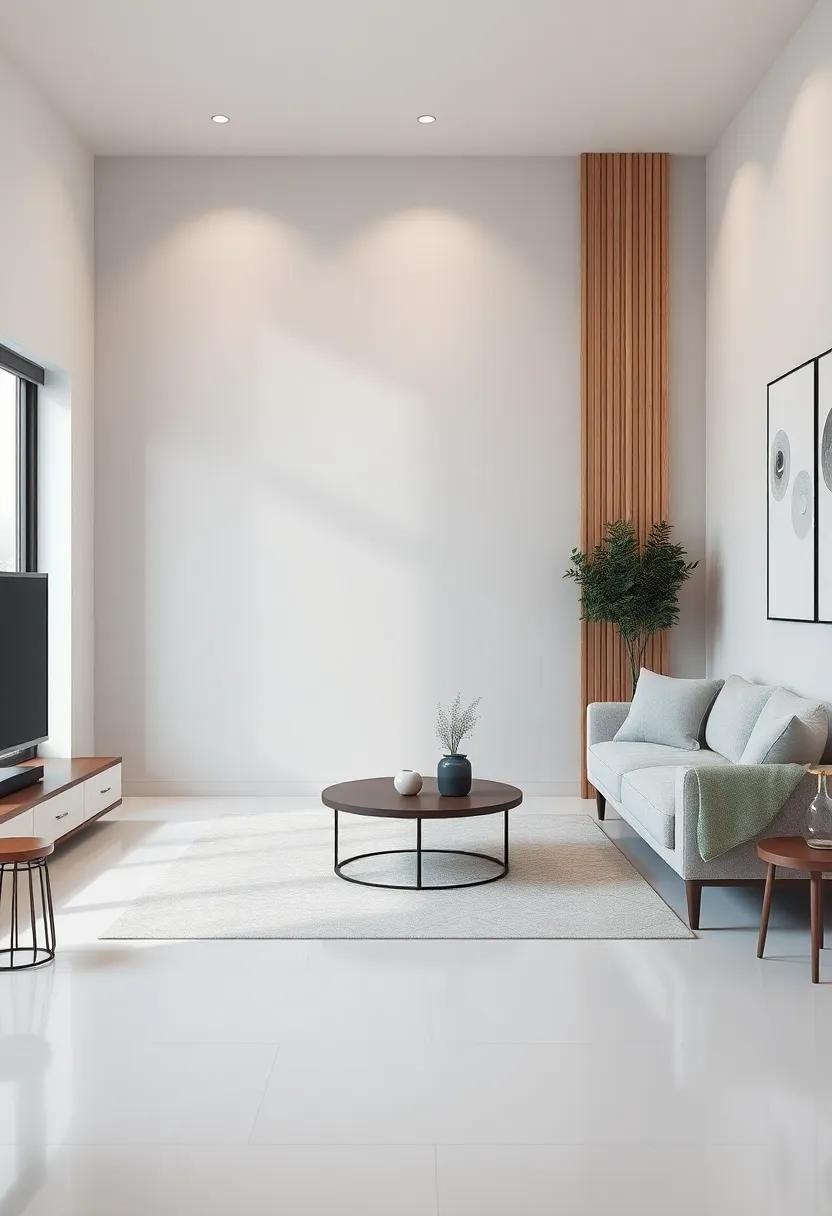
Incorporating elements that tell your personal story into a minimalist living room not only adds warmth but also infuses the space with authenticity. Begin by selecting a few key pieces that resonate with your journey—these could be travel souvenirs, family heirlooms, or handcrafted artwork. Aim for a curated approach, allowing each item to shine without overwhelming the senses. Consider organizing these treasures on a reclaimed wood shelf, which can provide both functionality and a rustic charm. You might also add a neutral-toned throw blanket or handmade cushion to narrate your journey toward simplicity and comfort.
To further enhance the connection to your experiences,think about including a small display table or a unique coffee table book that reflects your interests in minimalism or design. This not only acts as a conversation starter but also creates a focal point that invites exploration. Arrange your selected items in a way that balances visual appeal and empty space,adhering to the minimalist mantra of “less is more.” Here’s a quick look at ideas for personal touches:
| Personal Touch | Description |
|---|---|
| Travel Souvenirs | Curate a small collection that sparks joy and memories. |
| Family Heirlooms | Include items with emotional value to anchor the space. |
| Handcrafted Artwork | Support local artists by showcasing their work in a simple frame. |
In Conclusion
As we draw the curtains on our exploration of compact minimalist living room design, it becomes evident that simplicity is not merely a choice but an art form.The power of this approach lies in its ability to transform our everyday spaces into sanctuaries of peace and clarity. By thoughtfully curating our surroundings, we create an environment that nurtures tranquility, inspires creativity, and fosters genuine connection.
In a world brimming with excess, embracing simplicity is a gentle reminder that less can indeed be more. Each carefully selected piece serves a purpose, every hue is a brushstroke in the visual symphony of your living space. As you embark on this journey towards a minimalist lifestyle, remember that it’s not just about reducing clutter; it’s about making room for what truly matters.
So, take a deep breath, assess your space, and let go of the superfluous. In doing so,you’ll find not only a more harmonious living area but also the elements that reflect your unique spirit.Here’s to embracing simplicity and crafting a haven that resonates with serenity and style—one mindful choice at a time.
As an Amazon Associate I earn from qualifying purchases.

